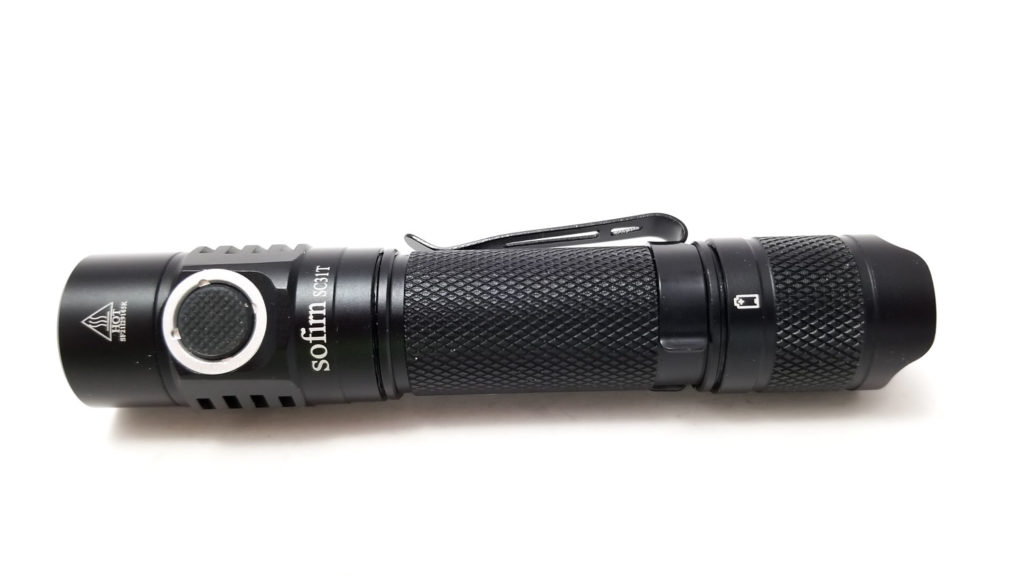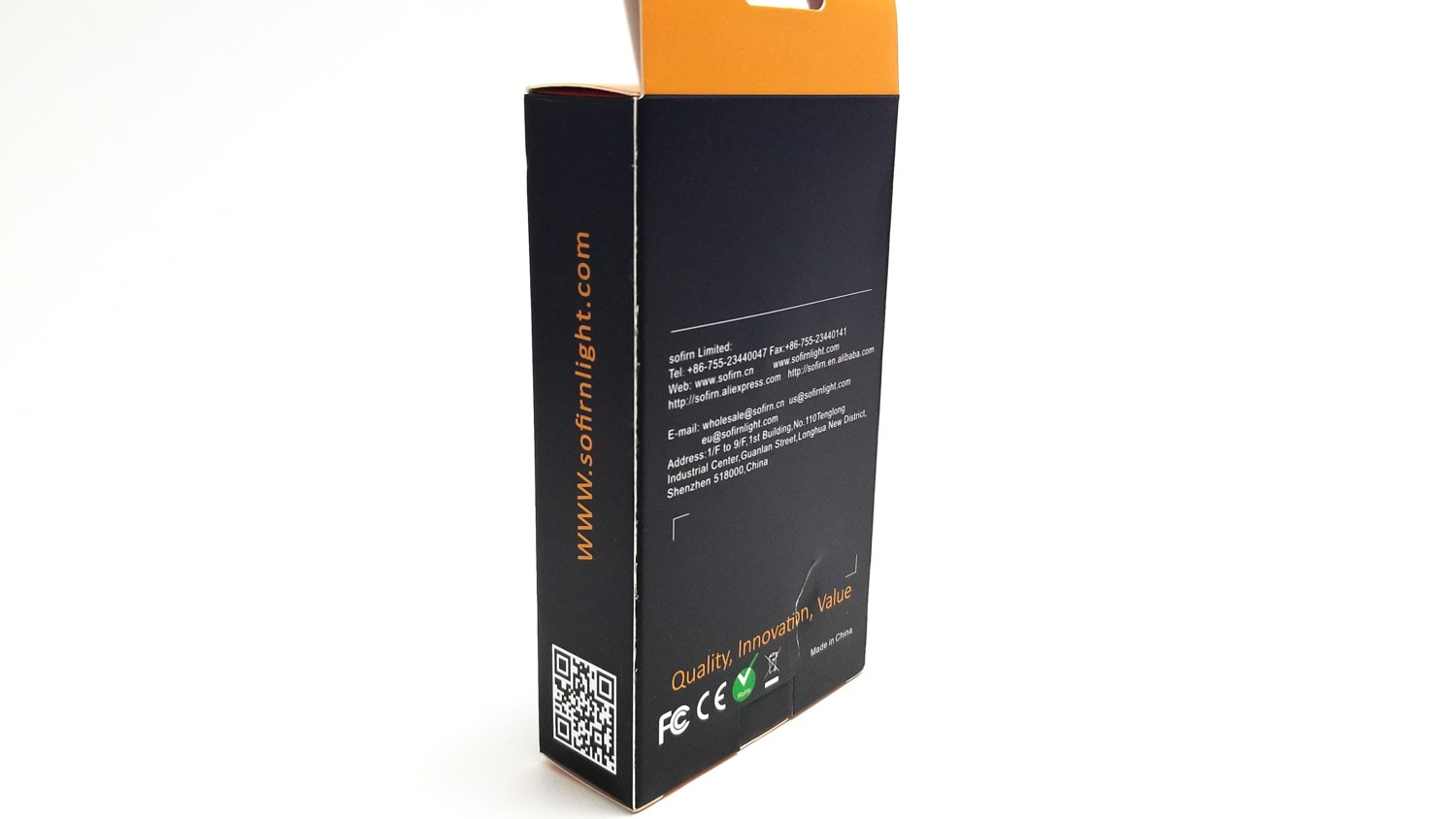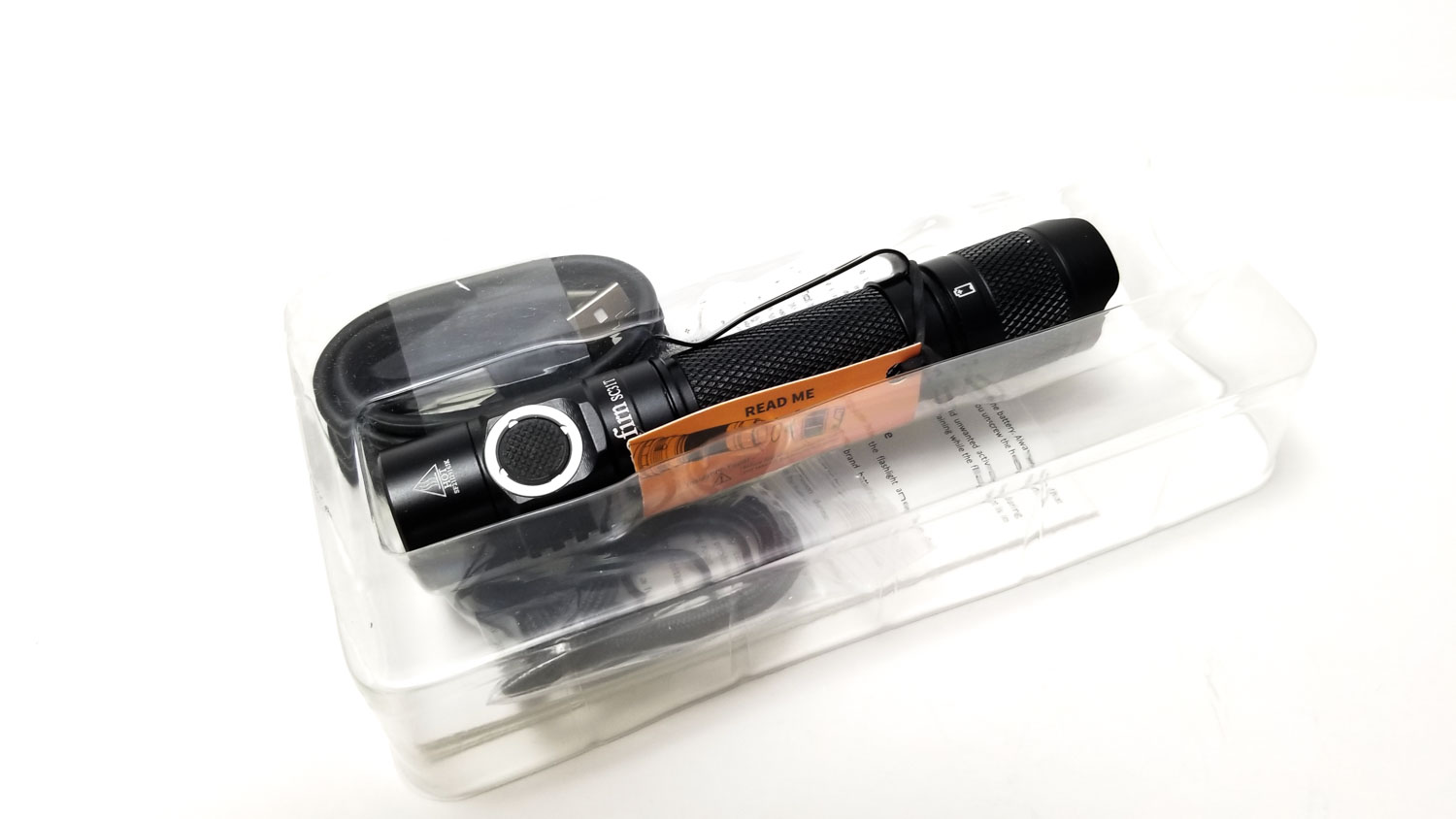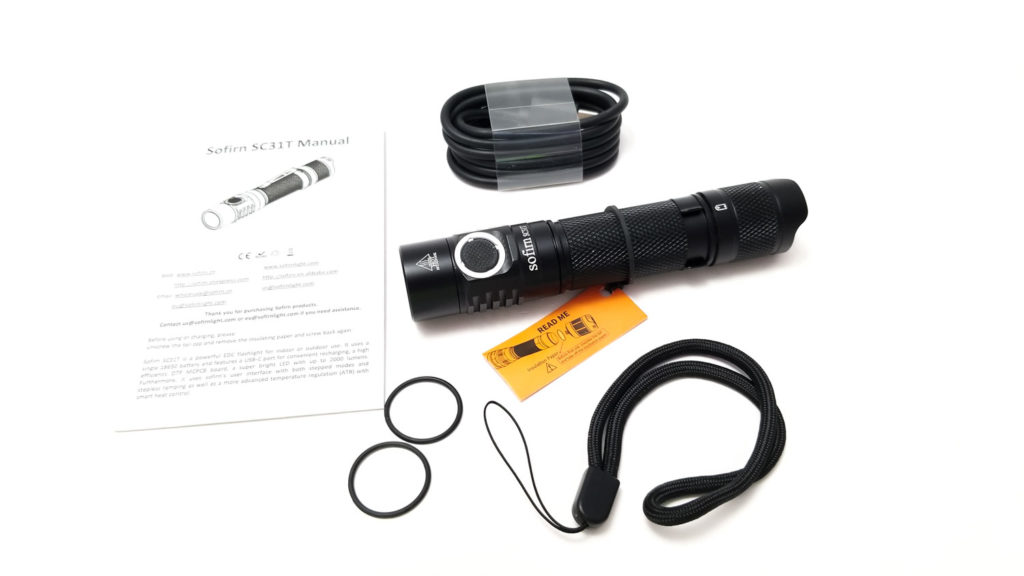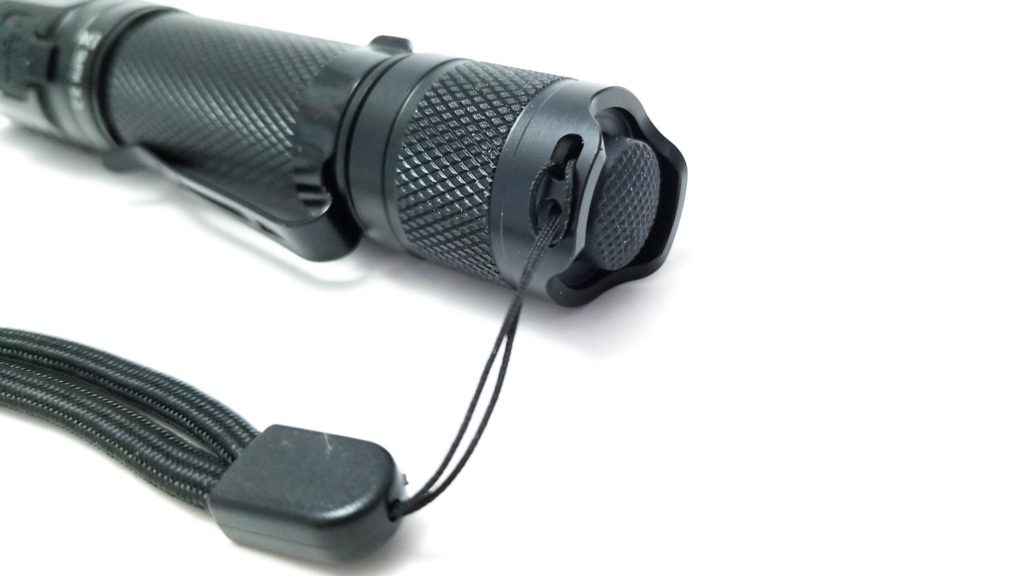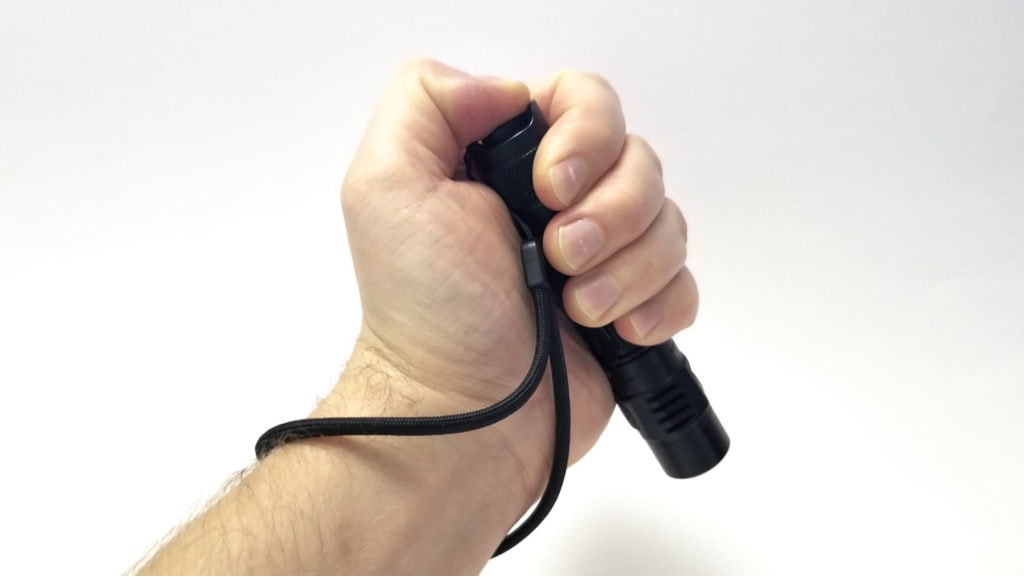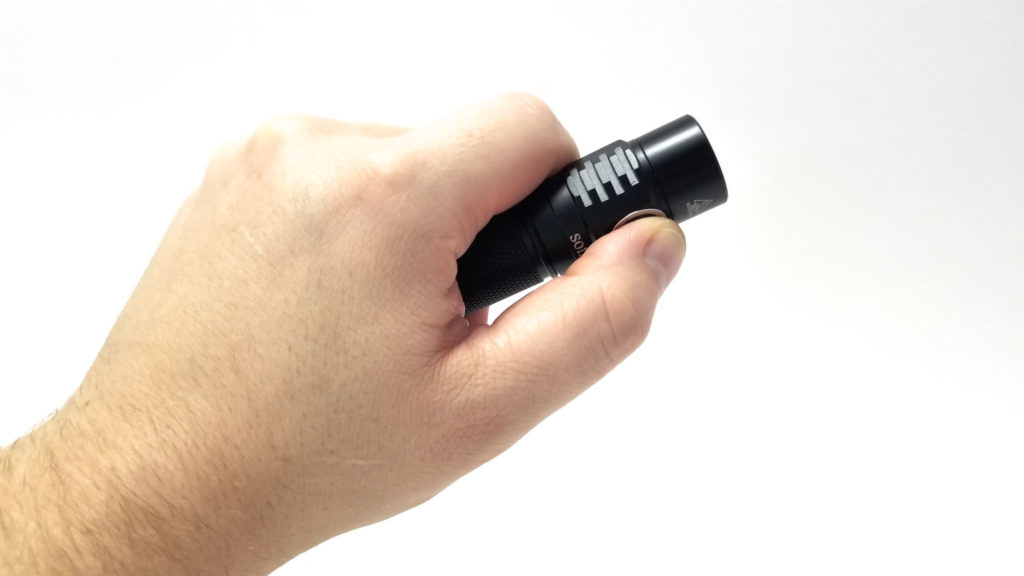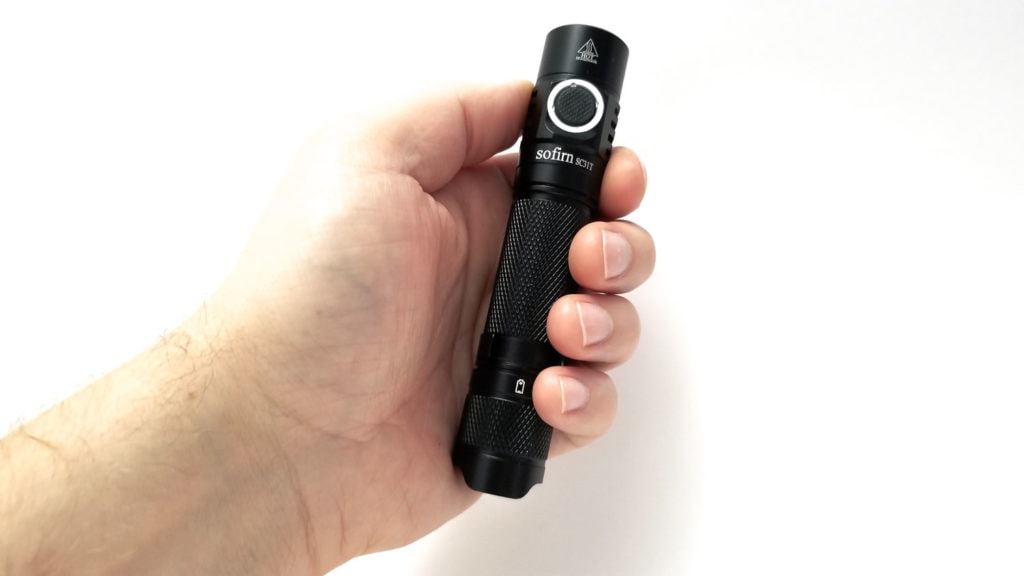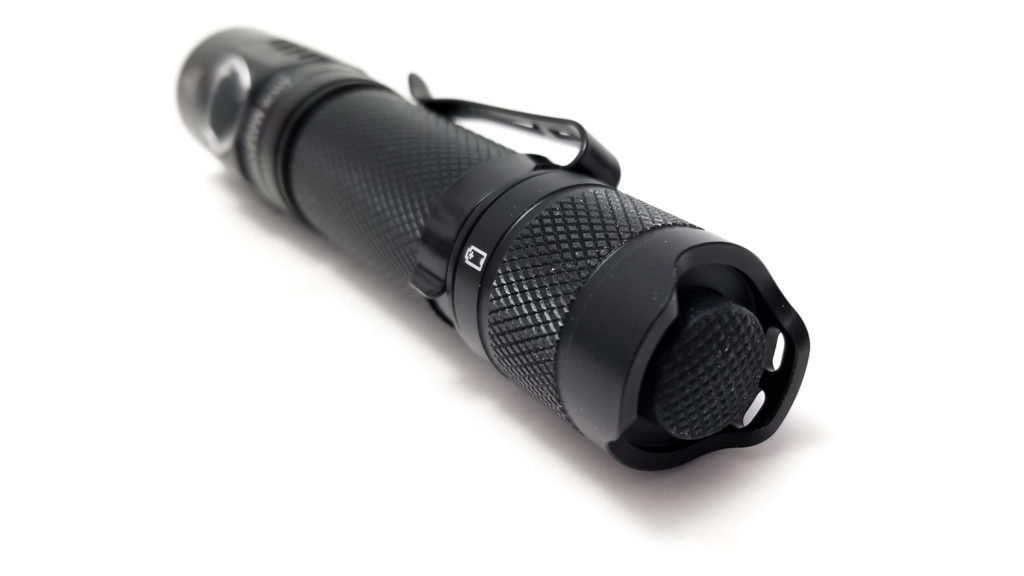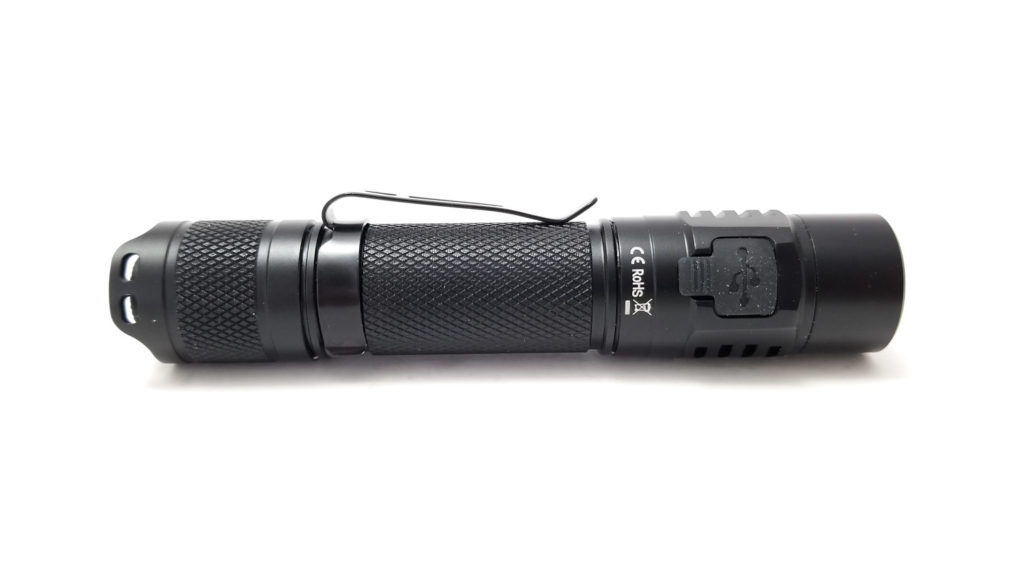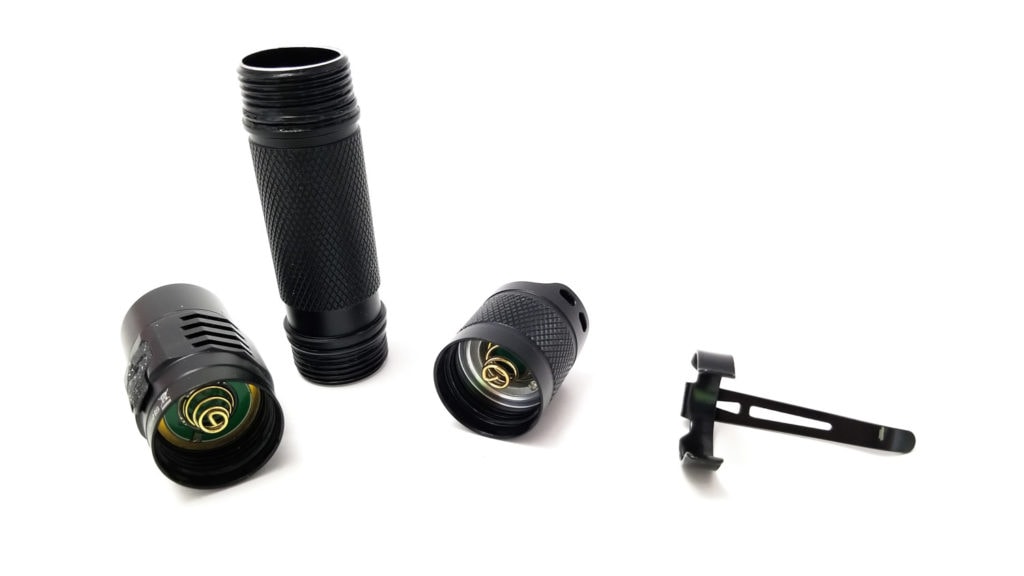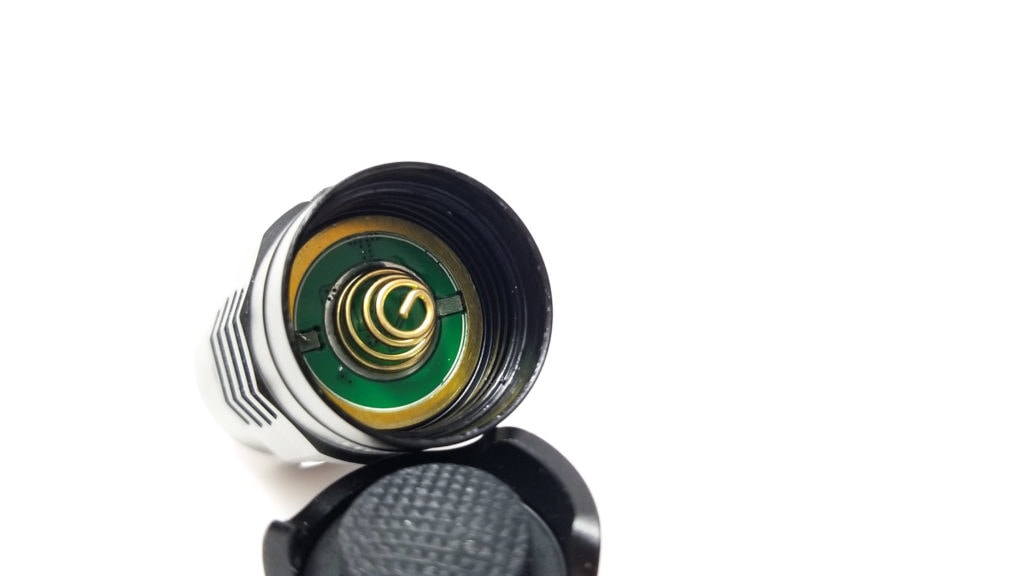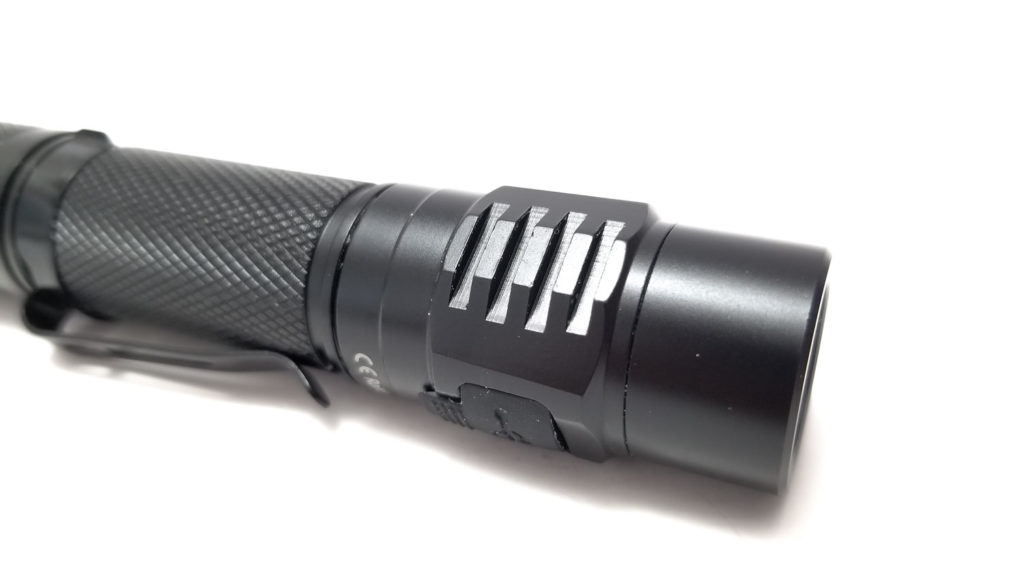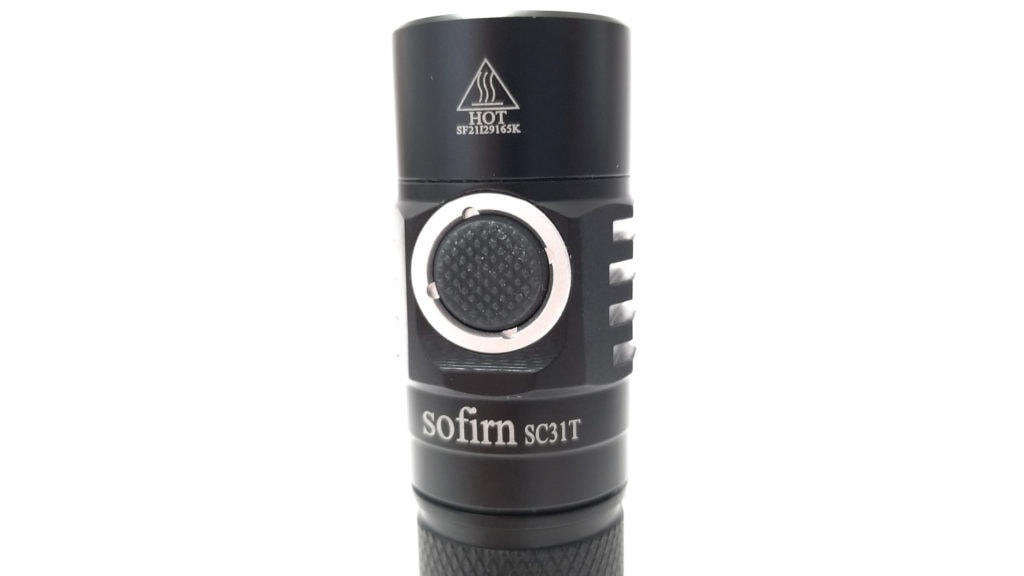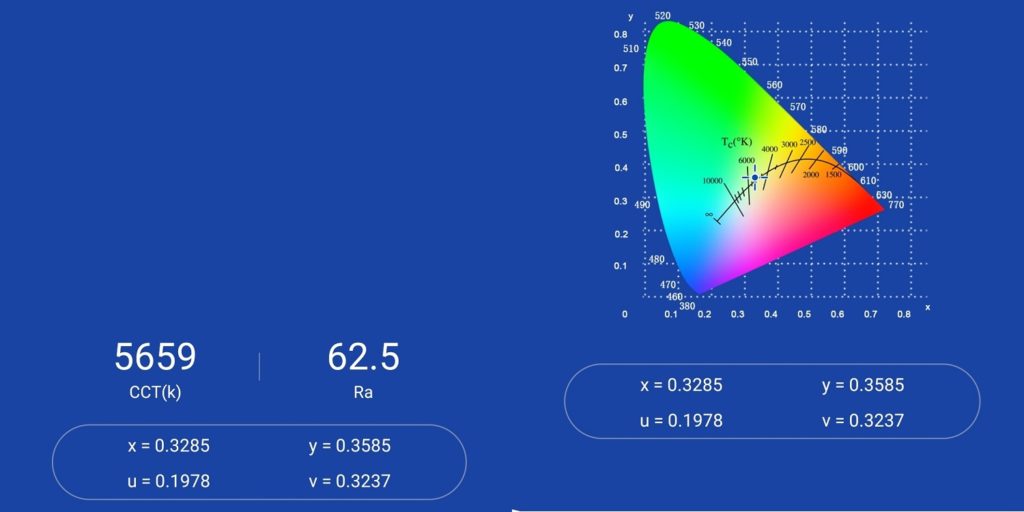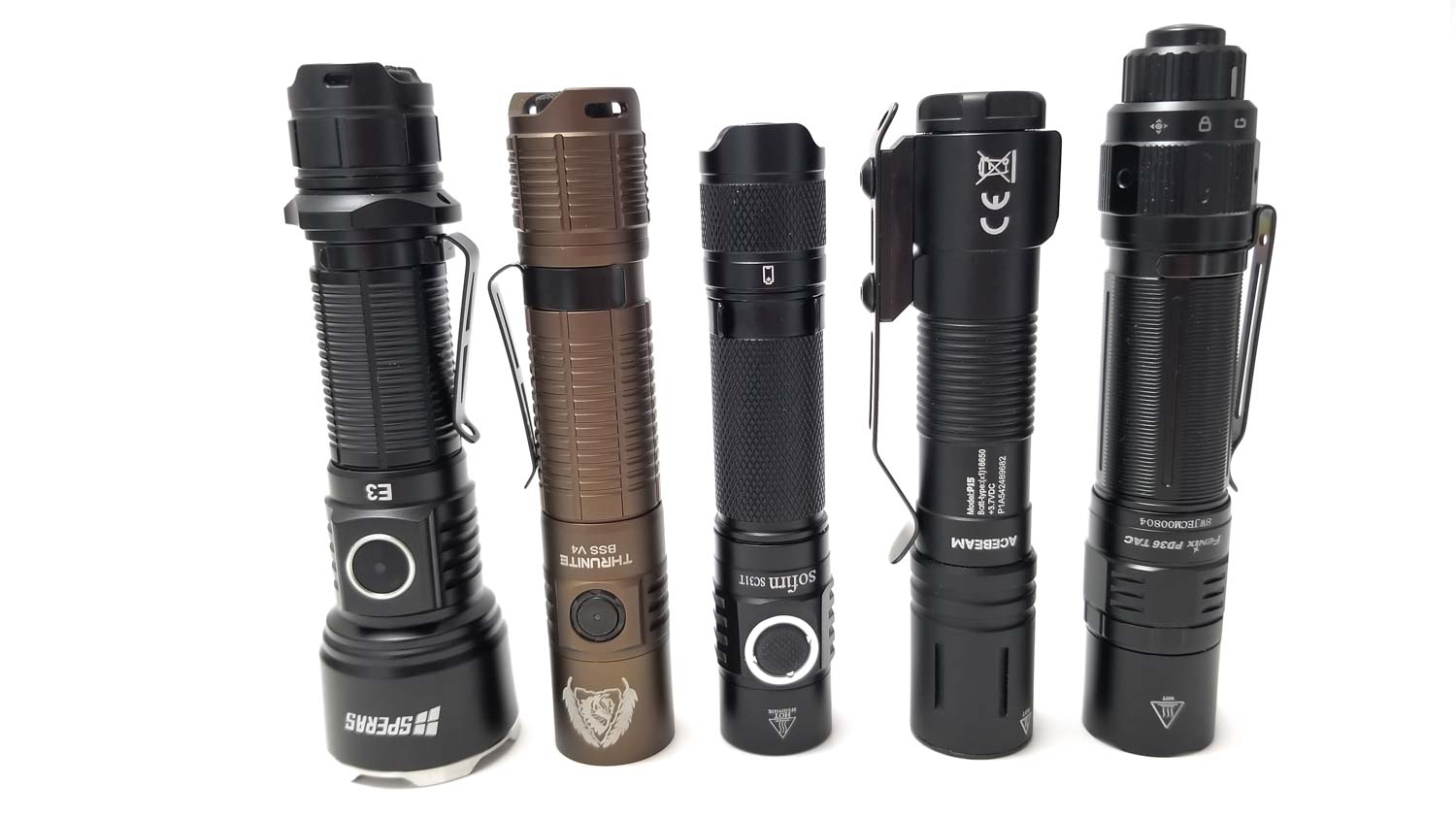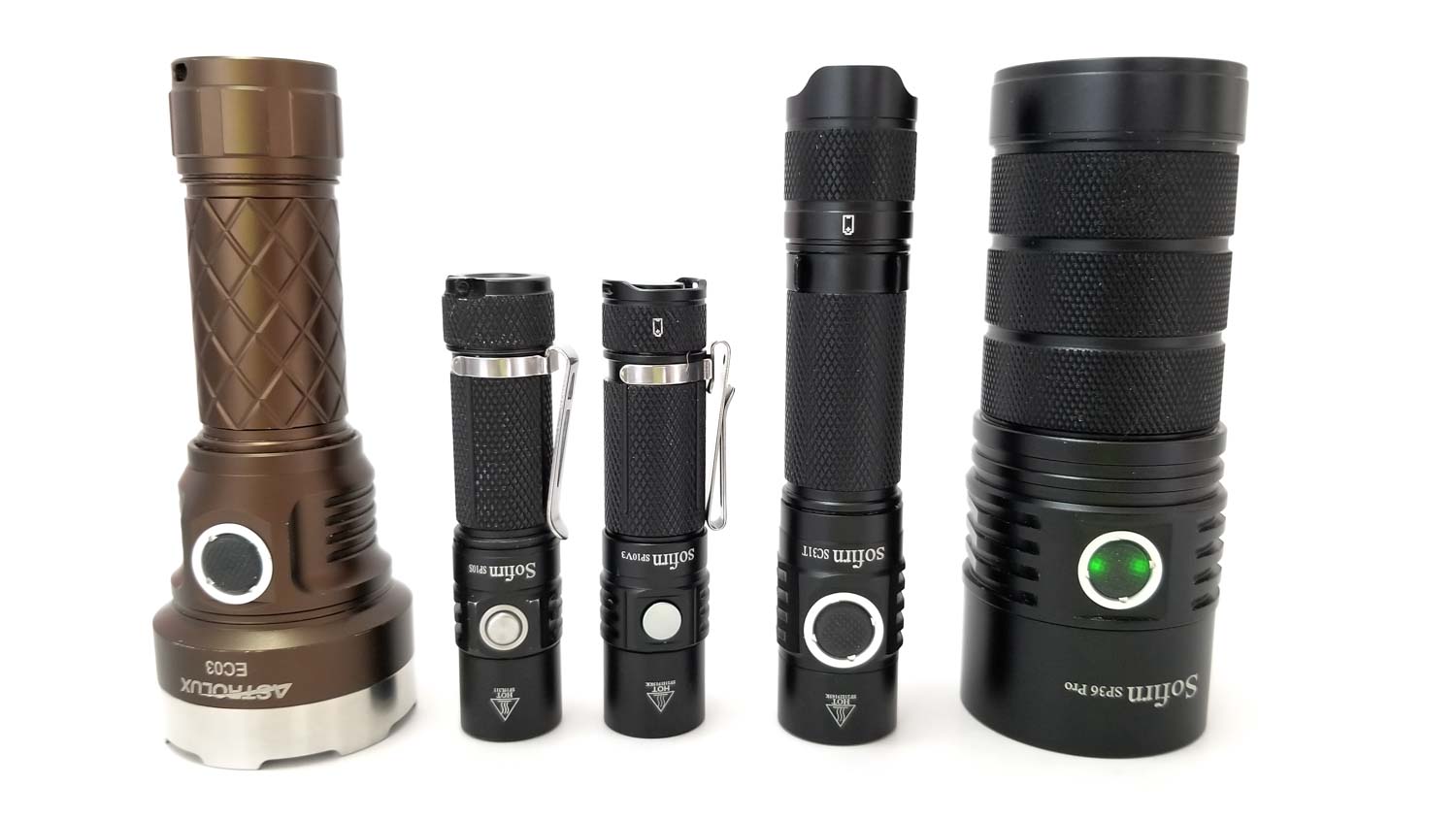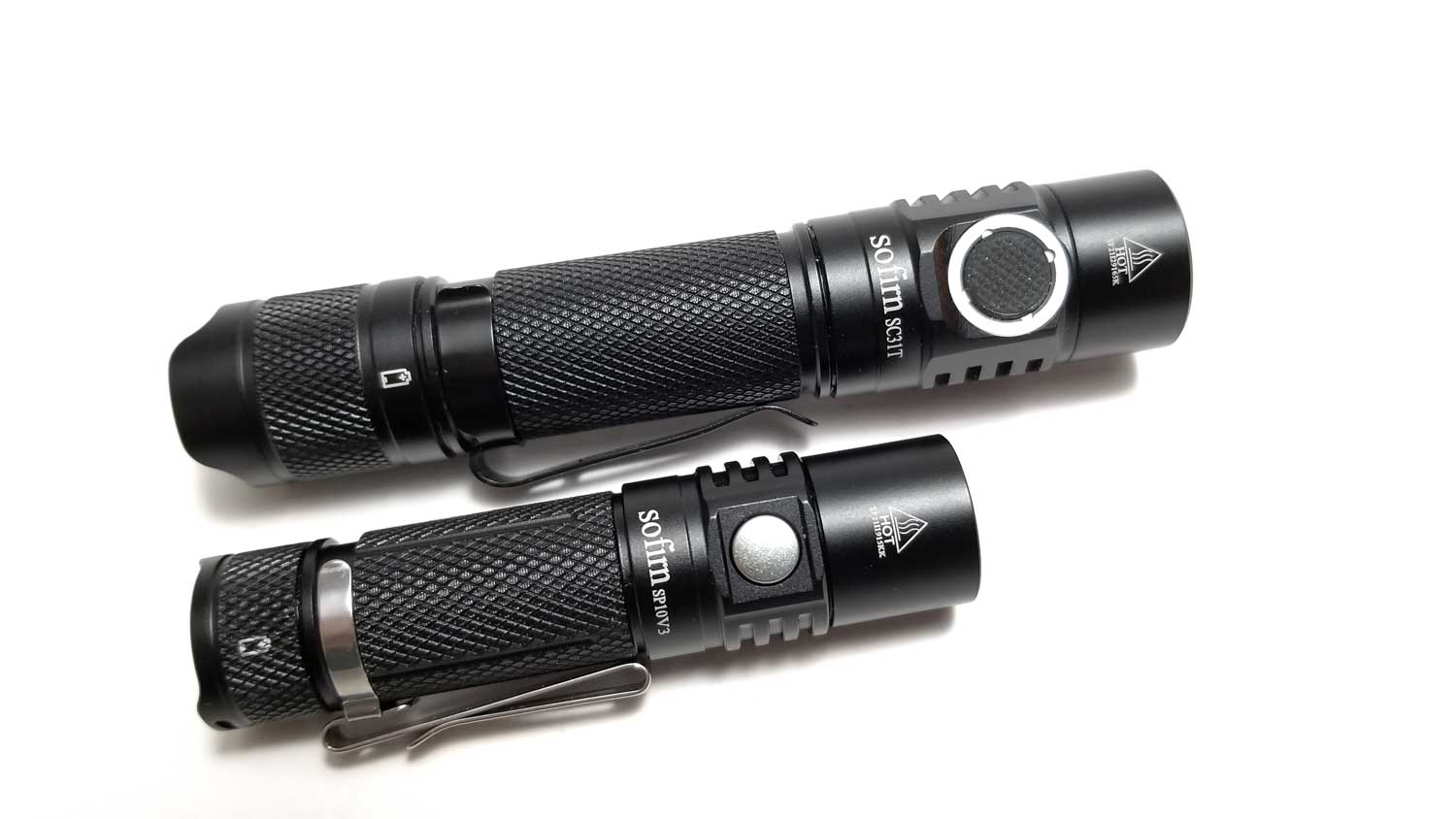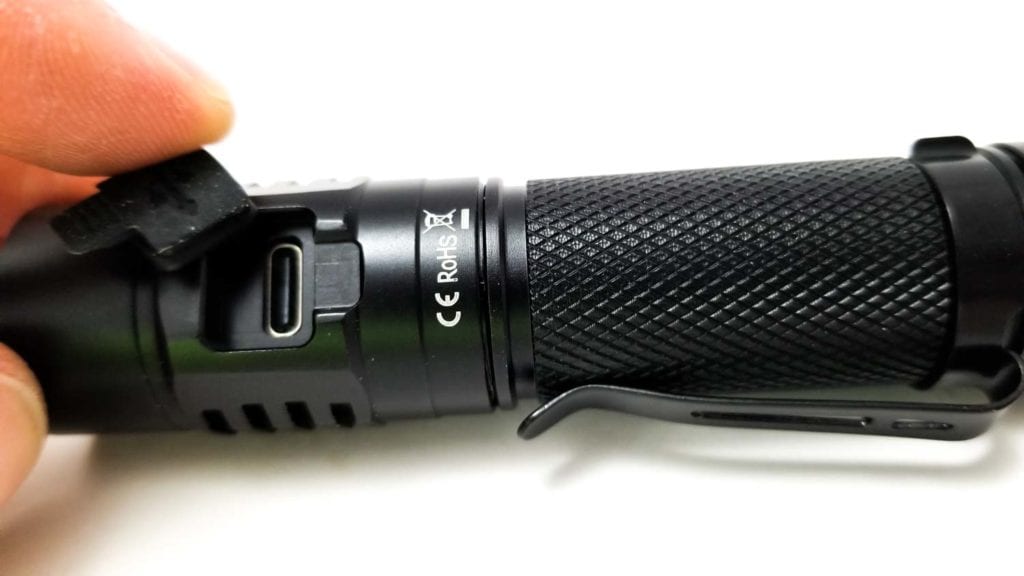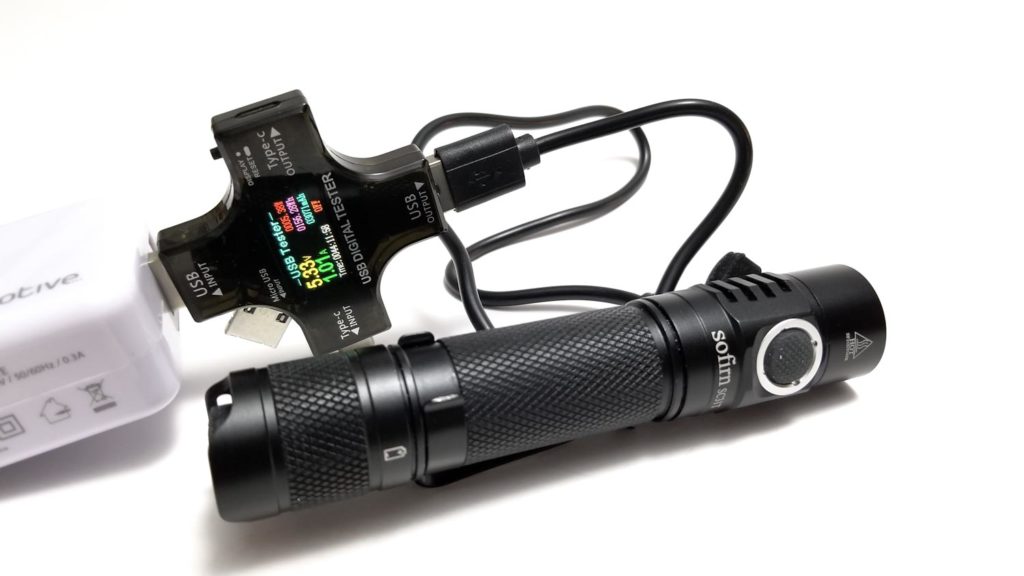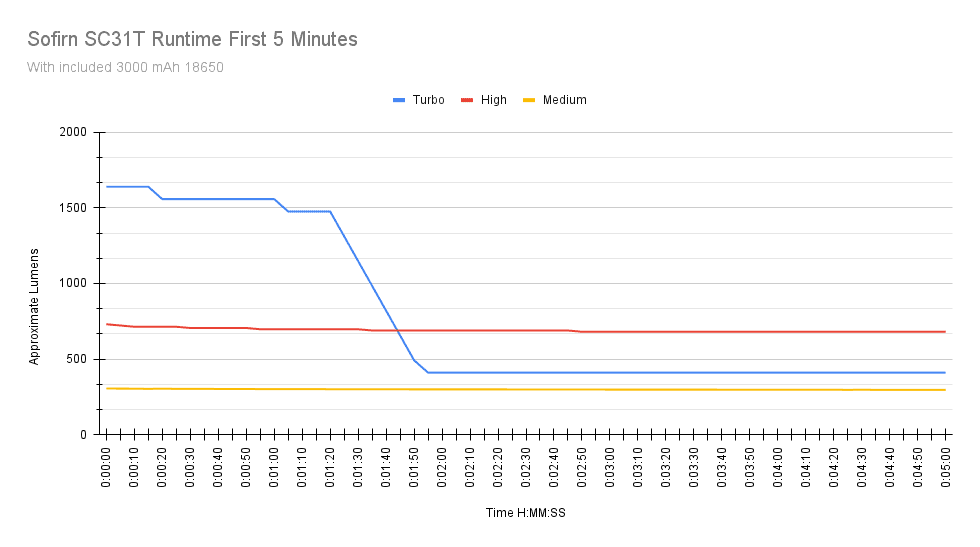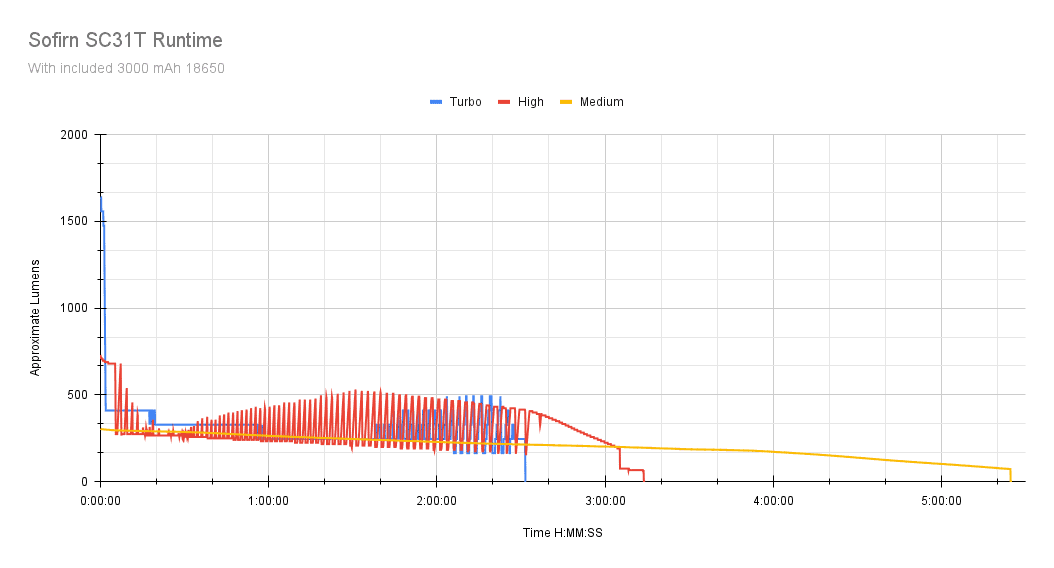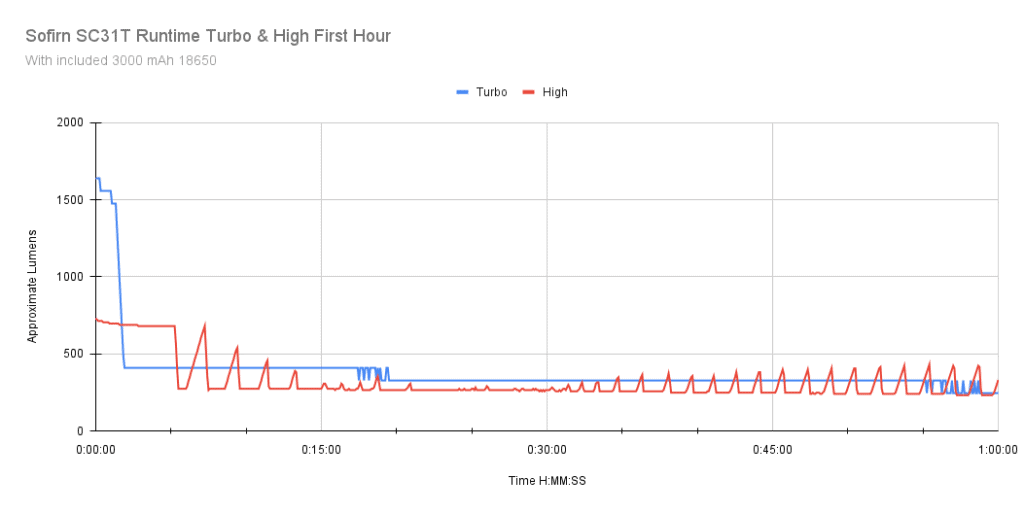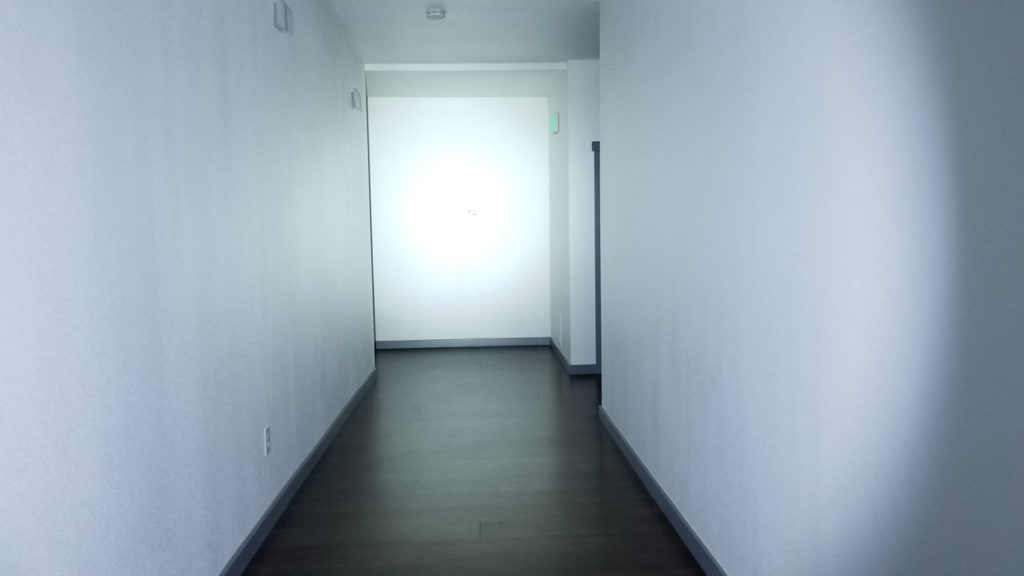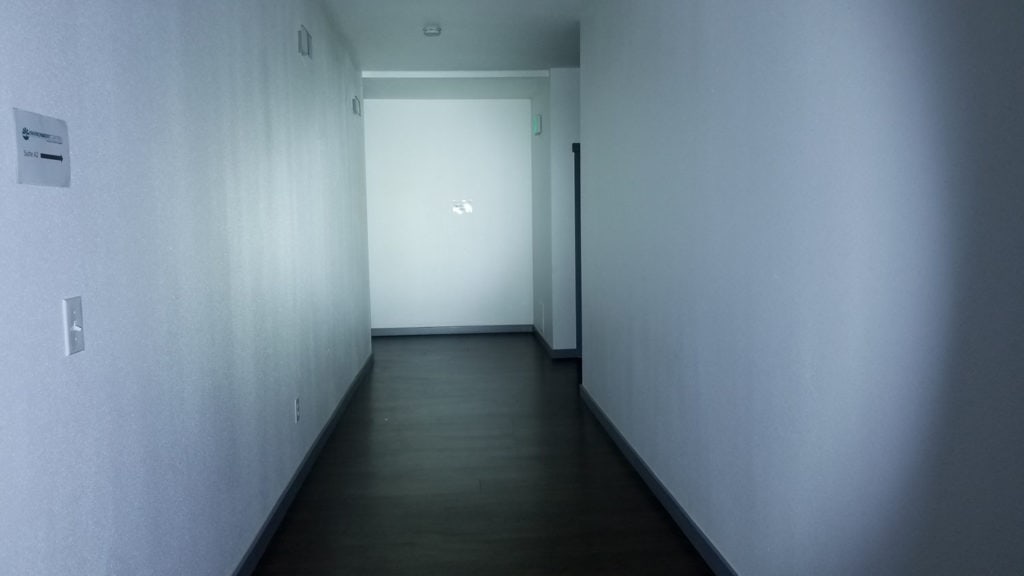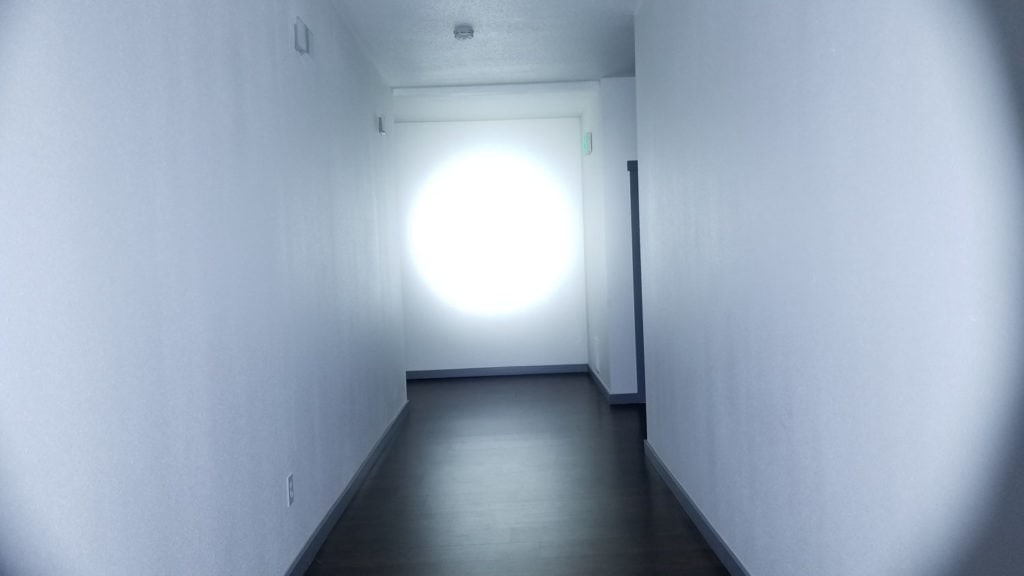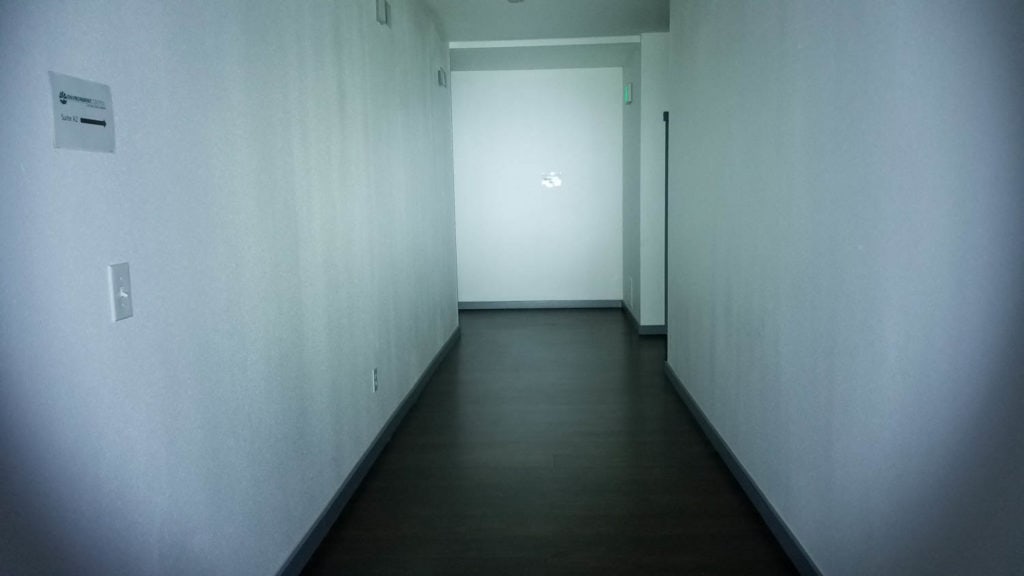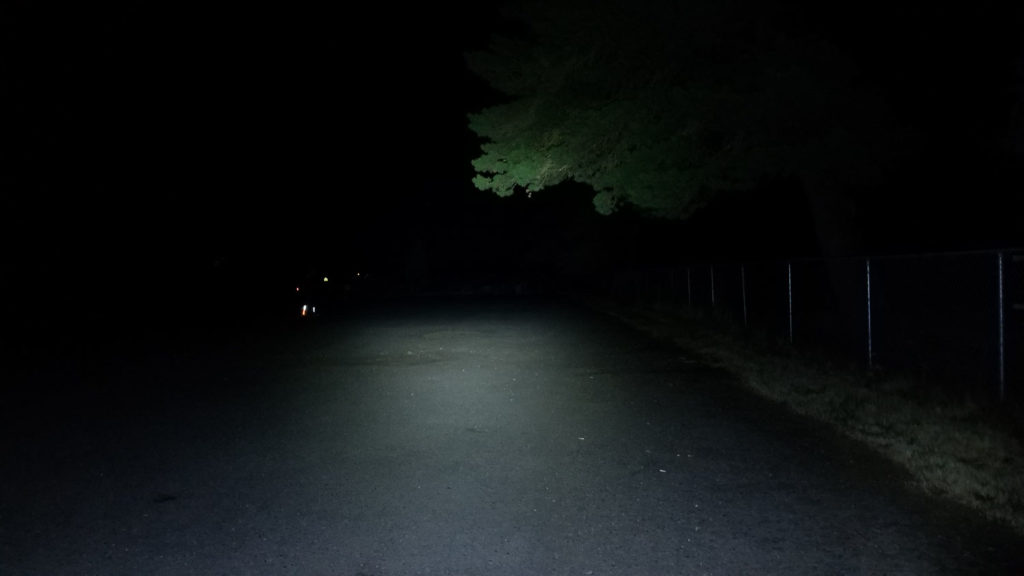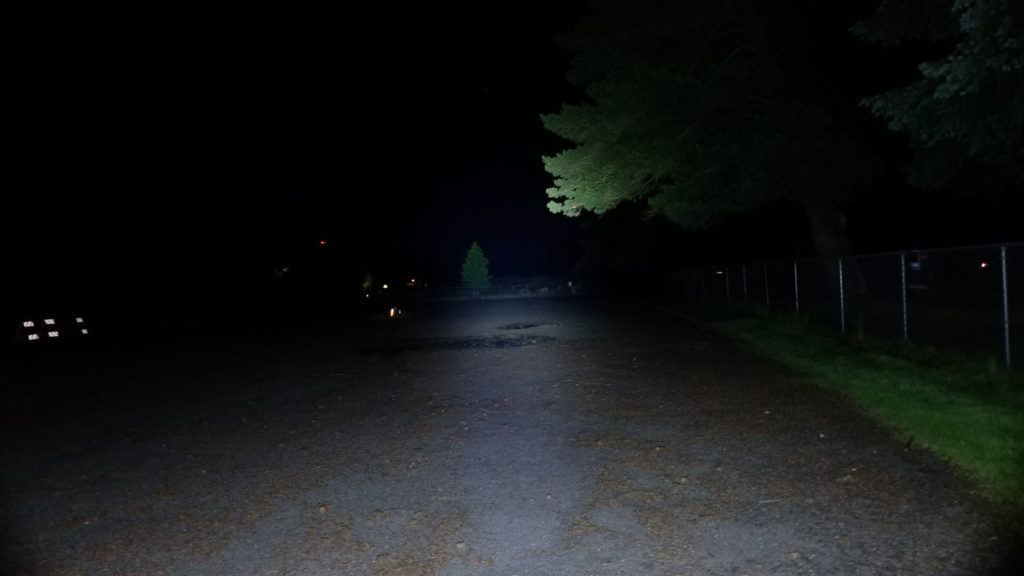1lumen selects and reviews products personally. We may earn affiliate commissions through our links, which help support our testing.
Sofirn SC31T review
Sofirn SC31T specifications
| Brand/model | Sofirn SC31T |
|---|---|
| LED | Luminus SST40 |
| Lumens | 2,000 lm |
| Beam intensity | 10,950 cd |
| Battery config. | 1*18650 |
| Material | Aluminum |
| Modes | 6 stepped+smooth ramping |
| Blinkies | Strobe, Beacon, SOS |
| Reflector | Smooth |
| Waterproof | IPX8 |
| Review date | November 2021 |
Introduction:
Okay, we all know Sofirn is an OEM factory making lights under their own brand, and making them for other companies (Wurkkos, and masquerading for Astrolux occasionally). Either way, they’re a popular brand. My first unmodified flashlight was a Sofirn SP10S I bought in early 2020, and this is a good illustration of how Sofirn has become firmly entrenched in the flashlight enthusiast’s repertoire.
Part of how they did this is by making lights we want to buy, selling them for cheap, and catering to the customer while improving and launching new products. So far it’s worked, since if you identify as a flashlight enthusiast, you probably have a Sofirn light.
The topic of our review today involves the latest addition to the highly successful SC series (SC denotes onboard charging, by the way). The first SC31 was an 18650 tube light with the Cree XP-G3 and micro USB charging. It was really affordable (around $20) and a decent performer, but nothing special. Subsequent versions were eventually upgraded to the Luminus SST40 for a big output bump, the charging upgraded to USB type C, and the UI was adjusted to incorporate a quasi smooth/stepped ramping.
As is the way of things though, the enthusiast nexus soon demanded an upgrade to the other stepped/smooth ramping UI, and Sofirn cordially obliged with the Anduril UI-equipped SC31 Pro, which quickly became a crowd favorite. Alas, there were those left wanting a more ‘tactical’ form factor with a more conventional UI and clicky switch, and their collective cries for were heeded, because Sofirn recently released the SC31T. I don’t know if T is for ‘tactical’ or not, but this version is sporting the original (well, last release) UI and added a forward clicky tail switch. Winning combination? I like simple UI’s, high output, and tactical lights, so let’s see!
Package quality.
Sofirn has never invested heavily in packaging, and the trend continues. The box is utilitarian, very retail-friendly, with the logo across the top and “LED Flashlight” in the middle with a graphic. It’s the exact same as the other SC31 models, with a quaint night time landscape theme. It maintains the simple matra outside, and inside, the light was riding in a molded plastic tray with the accessories underneath:
- Sofirn SC31T flashlight
- Sofirn-branded 3000 mAh 18650 battery (loaded in the light)
- USB type C cable
- Pocket clip (attached)
- User manual
- 2 spare o-rings
- Lanyard
This is a very comprehensive kit, and comes with everything you need to get going. The battery was preinstalled with a plastic isolator to keep it from dumping during storage, and when I pulled it, the battery read 3.7 volts, a good storage voltage. No complaints with the accessories, and once again, Sofirn includes their excellent USB type C cable. Like all Sofirn lights, they give you what you need to get going out of the box so it would be great for someone upgrading from a ‘beginner’ light.
Flashlight in use
The design is pretty conventional and nothing special, so the handling characteristics are on point, and typical for an 18650-size host. It’s covered in nice fine diamond-cut knurling on the body and tailcap for a super-secure grip. It’s nicely balanced as well. The front mounted electronic switch is carried over from the SC31 Pro, and features a large translucent rubber button with a machined aluminum retaining bezel. It’s nicely-sized for human hands, has the right amount of stick-out, and the click action is positive with good feedback and feel. There’s aux LED’s under the switch for battery and charging state as well, but they aren’t continuously illuminated, but do light up for a few seconds when the light is switched on to show battery state. The switch is set in a flat spot in the head and very easy to locate by feel.
The rear switch is also very nice, and has a cut on both sides of the tailcap for easy access with a thumb or finger. The switch has a large, grippy boot, and although the action is a bit firm, I liked the snappy clicks and feedback. It’s a forward switch, so basically it’s a momentary switch that latches when fully depressed. This is great for signaling or momentary use.
Both switches are easy to manipulate with gloves on as well. For retention, you can use the pocket clip and the tailcap has holes for threading a lanyard. The blackened stainless pocket clip is removable, and has good tension for clipping to thin or thick clothing, belts, collars, sleeves, MOLLE gear, you name it. Although the clip isn’t reversible, the tube can be reversed for bezel up or down carry. Thanks to the large lanyard holes in the tailcap, threading the lanyard was easy. Tail standing is not as good as a flat-bottomed tailcap, but still stable.
Build Quality, and Warranty
Part of Sofirn’s success is in the value department, and you really get a lot for your dollar with these lights. The SC31 Pro typically sells for around $25-$30 US with a battery and the obligatory accessories, and the T model is no different. Everything you see here sells for about $30 (direct from Sofirn). These days, when a store-bought apple pie runs $10, $30 for a complete flashlight kit is a great deal anyway you slice it.
The SC31T is well-made, and for the price, the build quality is totally fine. Now, it’s not Fenix or Olight-level fit and finish, but at roughly half what a Warrior 2 or PD35 V3 costs, it’s just fine. The machining is serviceable, and although there were some leftover machining marks on the head in between the heatsink fins, overall I can’t complain too much. Also, unlike my other Sofirn lights, there weren’t any sharp or abrupt edges on the SC31T, and all the parts fit together just fine with no anomalous gaps. The light is made from 6061 aluminum, coated in the obligatory black HAIII anodizing. It’s a nice finish, semi-gloss, and seems durable with great coverage and no bare areas or thin spots. I didn’t notice any excessive wear after removing and replacing the pocket clip several times.
I tried taking the bezel off, but it’s glued. You can remove the head though, exposing fully anodized (for mechanical lockout), acceptably large triangular cut threads (same as the tailcap end). They were nicely lubed and very smooth. There’s thick o-rings on both ends for waterproofing, and the charge port cover is decently thick and creates a good seal. Sofirn gives the SC31T a generic IPX8 rating for temporary immersion down to 2 meters.
There’s a nice (if a bit long) gold-plated spring mounted on a PCB for the tail switch, and the driver features a decently-thick gold-plated spring for the positive contact. These are good for durability and protect the battery and light from shock and connection interruptions if subjected to recoil (like if weapon-mounted). This is a good feature normally found on pro-use lights. The soldering for these is well done with no excess flux or solder bits. Thanks to an aluminum retaining ring, the tailcap can be taken apart for maintenance or replacement of the switch.
The warranty is pretty decent, and Sofirn has quite a bit to say about this, so Sofirn, you have the floor: If your Sofirn product has any defect as the result of the materials or workmanship we want to make it right! Within 30 days of purchase: Contact the original seller for repair or replacement. Within 2 years of purchase: Contact Sofirn for repair or replacement. This warranty does not cover normal wear and tear, modifications, misuse, disintegrations, negligence, accidents, improper maintenance, or repair by anyone other than an Authorized retailer or Sofirn itself. Of course, this warranty does not cover normal wear and tear. IF YOUR LIGHT HAS SIGNIFICANT DAMAGE AND IT IS SENT TO US, WE WILL SEND IT BACK TO YOU. This warranty also does NOT cover modifications, misuse, disintegrations, negligence, accidents, improper maintenance, or repair by anyone others. BUYER IS RESPONSIBLE FOR RETURN SHIPPING COSTS. Please note that the warranty process may take 3-4 weeks to get it back to you. *Accessories such as pocket clips, holsters, and charging cables are not under the 5 years warranty. These are accessories given for free with our products. Batteries are currently under a 1 year warranty. To fulfill the warranty, we usually send parts for repairing because shipping back to us costs too much according to the flashlight values. If customers agree, we would love to offer a huge discounted price for a new one as replacement.
LED, Lens, Bezel, and Reflector
The recent Sofirn SC31 series features the workhorse of the LED world Luminus SST40. Two tints are available, either 5000K or 6500K, which will keep the tint-conscientious (somewhat) happy. The SST40 is a great choice and probably one of the most well-rounded emitters available, and is found in every nook and cranny of the flashlight continuum. It’s efficient and has a low forward voltage, but can be direct-driven with good heat sinking for very high output. My sample came with the 6500K version, and that’s fine since pro-users don’t care about tint or CRI, plus it gets brighter than neutral or warmer tints, and we all know Lumens (whether real or fake) sell, right? The smooth reflector is flawless and free of debris or crud, and the mineral glass lens is not AR coated (from what I could tell). The LED is perfectly centered with a white centering ring. The large bezel is not crenulated, and the lens is set back about 2.5 mm for drop protection. It’s also glued on, so no peeking inside this time!
The beam is nothing special and a mix of flood and throw, but mostly flood. As expected, the beam is a little green at low currents, and is only visible on white walls, but goes away quickly with increased brightness. The hotspot is large and focused, but blends into the abundant spill very nicely. There are some artifacts on white walls, with ugly rings n’ things, and they unfortunately detract from the overall beam quality. There’s enough throw for out to 100 meters and I think the beam is very useful for EDC or duty purposes.
Dimensions and size comparison
- Length: 12.55 cm / 4.94 inches
- Head diameter: 2.4 cm / 0.94 inches
- Body diameter: 2.4 cm / 0.94 inches
Weight:
- Without battery: 67.5 grams / 2.38 oz.
- With included 18650 battery: 113.8 grams / 4.0 oz.
Flashlight comparison
I compared the SC31T to some other tactical/duty lights I have, and of course I threw in its Sofirn stablemates.
Group 1 left to right: Speras E3, Trunite BSS V4, Sofirn SC31T, Acebeam P15 Defender, Fenix PD36 Tac.
Group 2 left to right: Astrolux EC03, Sofirn SP10S, Sofirn SP10V3, Sofirn SC31T, Sofirn SP36 Pro.
Groep 3: Sofirn SC31T and Sofirn SP10v3
Driver & User Interface:
The driver is a bit of a mystery. Sadly, Sofirn didn’t include the excellent buck driver from the SP35, so we’re probably getting some kind of FET+1 driver in the SC31T; possibly a carryover from the SC31 Pro.
The UI is like a chopped-down version of Anduril since you get smooth ramping with double-click for Turbo, and a more conventional 5 mode plus Turbo available on a second mode group. You get 3 blinky modes as well.
Available modes: Smooth ramping by default, with a 2nd user-selectable mode set consisting of Eco, Low, Med, High, and double-click for Turbo. Triple-click for strobe, and double-click to cycle through SOS and Beacon.
From OFF:
- Single click rear switch: Turns on in last mode
- Single click side switch: N/A
- Double-click side switch: N/A
- Triple-click side switch: N/A
- Press and hold side switch: N/A
From ON:
- Single click rear switch: Turns off
- Press and hold side switch: Ramps up/down when in ramping mode
- Single click side switch: Changes between Eco-L-M-H in stepped mode
- Double-click side switch: Turbo
- Triple-click side switch: Strobe (double-click to cycle through SOS and Beacon)
- Quad-click side switch: Switches between smooth ramping and stepped mode groups
Mode memory:
- Yes (Strobes and Turbo are not memorized)
Shortcuts:
- Double-clicking the side switch when on activates Turbo. Triple-click activates Strobe. To change between SOS and Beacon modes, double-click while in Strobe mode.
Low voltage warning:
- Yes. The LED indicators in the side switch will flash red rapidly, and when the battery hits 3 volts, the light steps down to a very low level. After a while, the light will shut down.
Strobe/blinkies
- Variable strobe, SOS, Beacon flasher.
Lock-out mode:
- No. Manual lockout by unscrewing the head or tailcap 1/6th turn
PWM
- Yes, but fast PWM and not visible to the naked eye.
Additional info on the UI:
I’m going to hypothesize that the SC31T was Sofirn’s answer to the collective cries of those with a disdain for complex UI’s, who loved their SC31 Pro, but not Anduril, and I think the SC31T UI is a compromise since it offers the smooth ramping we all know and love in addition to more conventional clicky modes. Sofirn also includes their version of ATR set with a 40 C thermal ceiling (yep, I’ll test that). It’s far from perfect though, and I found the smooth ramping a bit weird, but functional. When ramping, it’s not nearly as smooth and seamless as Anduril, and the ramp from the bottom goes pretty quick, then seems to slow down as you get to the top of the ramp, signaled by a blink before it hits the ceiling, (according to the manual, this is Turbo). The blink is probably the switchover to the FET. There’s a lot of brightness levels with the smooth ramping, and the stepped modes are drama-free, and nicely spaced.
Switching between smooth and stepped ramping takes 4 quick clicks of the side switch, confirmed with a couple blinks. Fun fact: On Turbo, I didn’t even see PWM on the camera, so it must be true direct drive? The rear switch is kind of a let down here, since the purpose of a forward switch on a ‘tactical’ light is for instant Turbo mode and I was expecting that, but that’s not the case because the rear switch functions like an on/off switch. With the rear switch in the off position, the side switch is useless as a screen door on a submarine.
Batteries & Charging
The Sofirn SC31T retains the SC31 series single 18650 lithium-ion battery configuration. Sofirn could have gone with a 21700 cell to bring it into the 21st Century, but I like the 18650 form factor in this light since it keeps the size and weight down. If you want extra runtime, you can easily swap in a high capacity 18650 like a Sanyo GA or Samsung 35E and go on down the road.
Thanks to the dual springs, flat top Sanyo GAs and Sony VTC6s fit just fine, same with a protected Thrunite 18650, and it even digested my longest Acebeam 18650 (over 70 mm) with protection board and integrated charging. Nice! The light came with Sofirn’s 3000 mAh button top 18650, and this cell gets passed around between other Sofirn and Wurkkos lights, and I think this iteration is a Lishen brand cell wearing a Sofirn uniform (it has the characteristic bottom vent). These Chinese-made cells are pretty decent cells, by the way and should give good service. Another carryover from the Pro version is the onboard charging. It’s the familiar USB type C, and Sofirn pegs it at 1 amp. That’s not rapid charging, but not slow either, and should charge the battery in about 3 hours. I saw 1 amp on the nose on my USB tester, and it worked with a C to C cable also (output current unchanged).
Performance
Lumen measurements:
I measured Lumens using my 30 cm integrating sphere with a Digi-Sense 20250-00 data logging lux meter that’s been calibrated with several lights of known output. Tests were conducted using a fully charged 3000 mAh 18650 cell using the stepped modes (not smooth ramping). Amps and output were measured using the included cell, but to evaluate the light’s full capabilities, I also tested it with a Sony VTC6.
| Mode | Amps at start | Specs | start | 30 sec | 10min |
|---|---|---|---|---|---|
| Eco | 30 mA | 10 lm | 9.96 lm | 9.96 lm | – |
| Low | 225 mA | 80 lm | 73.87 lm | 73.87 lm | – |
| Medium | 740 mA | 300 lm | 305 lm | 303 lm | 293 lm |
| High | 2.15 A | 800 lm | 730 lm | 705 lm | 274 lm |
| Turbo | 6.4 A | 2000 lm | 1640 lm | 1558 lm | 410 lm |
The numbers are down a bit on the higher settings, but close. The included cell is only good for about 10 amps CDR, so I wasn’t expecting big numbers. I tried a Sony VTC6 and ran the test again. The lower modes didn’t show much of a gain, but Turbo and High were another story: Turbo jumped to 1983.7 Lumens, and High hit 846.6 Lumens. I suspect if you bypass the springs, it would go up even more.
Parasitic drain:
- N/A. Although I did measure 2.3 microamps, the clicky switch cuts the current path, so it’s essentially zero
Runtime graph
Runtime tests were conducted using the 30 cm integrating sphere with the Digi-Sense 20250-00 data logging lux meter calibrated using several lights of known output. I used the included fully charged 3000 mAh 18650 battery for each test and tested Turbo, High, and Medium modes.
Turbo started at 1640 Lumens, and only held that for about 15 seconds before the output started dropping to 1558 Lumens, which it held for another 45 seconds. The output stayed over 1000 Lumens for about 1 minute 25 seconds, which isn’t bad for a small tube light. At 5 seconds (ambient 24 C) the head hit 32.7 C, by 20 seconds it’s 44 C, and by 60 seconds it’s 55 C and the output had dropped quite a bit. At 2 minutes, the temp is down to 52 C, and the temperatures never went over 56 C, and the tube stayed toasty at 51 C by 30 minutes. The output fell off a cliff by 1 minute 55 seconds down to 410 Lumens, and dwelled there for the next 18 minutes, dipping to 328 Lumens by 20 minutes in, and stayed steady for another 20 minutes before the ATR kicked in. Yep, ATR on this light is real, and it does a good job, keeping the head to around 44 to 46 C for the next 40 minutes or so, with the output jumping between 146 and 410 Lumens. There’s no LVP blinkies, but the side switch blinks red to signal it’s time to change the battery. The light didn’t shut off abruptly, but dropped down to a very low level and off the lux meter scale by 2 hours 31 minutes and I ended the test. Sofirn specs 2.5 hours for the runtime, so hey, Bob’s your uncle! The battery read 2.92 volts when I pulled it after the test.
High started at 730 Lumens and held over 600 Lumens for the next 5 minutes 25 seconds before the first big step down at 5 minutes 30 seconds to 273 Lumens with the head showing 46 C. The temps never really rose over 45 or 46 degrees the entire runtime, and the tbe was always cool enough for hands. Nice. ATR kicks in shortly after the step down, and by 5 minutes 35 seconds, it’s in full swing, with the output jumping around from 240 up to 514 Lumens for the next 2 hours. At 2 hours 35 minutes the output has stabilized at around 400 Lumens, and experiences gradual drops over the next 45 minutes until a hard step down at 3 hours 13 minutes and (again) off the lux meter scale and I ended the test. Sofirn’s spec? 3.5 hours. Again, the battery was right at 2.9 volts.
Medium was about as exciting as a game of Bingo at the local grange hall. Medium doesn’t fall under a regulated mode at 740 mA, so it’s still running on a MOSFET or some other regulator using PWM. The test started at 305 Lumens, and that didn’t change much, with gradual decreases in output as the battery drained. The output didn’t drop below 200 Lumens until 3 hours and 5 minutes in, then down to 150 Lumens by 4 hours 20 minutes, and under 100 Lumens by 5 hours 2 minutes. The output dropped to 72 Lumens before dropping off the scale at 5 hours 24 minutes. Sofirn’s wayyyy off here with their 7.5 hour runtime, but this is still a good figure. The light never got over 40 C the entire runtime.
Not much to say here, other than it’s expectedly not professional-grade performance or regulation, but for under 40 bucks, I wasn’t expecting that. I can’t pull the driver to verify the configuration, but my guess is it’s the same one as the Pro model with a different MCU. The runtimes aren’t anything special or remarkable either, but with a good battery the SC31T would give good service and decent runtimes. The ATR: Yes, it works, and it seems like the “older” version of Sofirn’s ATR found on the SP3x models, and I suspect may be found on Wurkkos’ non-Anduril lights as well. Speras’ E3 also has a version of this ATR algorithm with the sawtooth behavior. Not as smooth or seamless as Anduril or some others, but hey, it works fine and your eyes can’t tell it’s working. I also liked how the flashlight was still usable after the tests, so even if you run the battery down, you still have some useful output to work with.
Throw numbers:
Throw was measured at 5 meters indoors using the Uni-t UT383S lux meter. I used the fully charged included Sofirn 3000 mAh 18650 battery for the test. Readings were recorded at 30 seconds.
| Mode | Specs | Candela measured | Meters |
|---|---|---|---|
| Eco | 91 cd | N/A too low | N/A |
| Low | 46 cd (not a typo!) | 525 cd | 46 |
| Medium | 1808 cd | 2225 cd | 94 |
| High | 4408 cd | 5700 cd | 151 |
| Turbo | 10,950 cd | 13850 cd | 235 |
The candela figure for Low is NOT a typo. That was pulled from the Sofirn website, but I got quite a bit more than that. The throw figures are all up from Sofirn’s figures anyways. Again, pretty standard for a small tube light, but enough throw to be useful for just about any task.
Beamshots
I tested the SC31T against some tactical and semi-tactical “duty” lights: Fenix TK16 V2 (3100 Lumens SST70, 400+ meters throw), Fenix PD36 TAC (3000 Lumens SST70 300+meters throw), Thrunite BSS V4 (2500 Lumens SST70 250 meters throw), and Acebeam P15 Defender (SFT40-W 1700 Lumens 370 meters throw).
Indoor shots: The end of the first hallway is 7 meters away.
Outdoor shots: The fence is 95 meters away.
Disclaimer: This flashlight was sent to me for review at no cost by Sofirn. I have not been paid to review, nor have I been holding back on problems or defects.
Final Verdict
Pros
- Lightweight
- Type C onboard charging
- Good build quality
- Great value with all included accessories
- Smooth or stepped ramping UI
- Decent output
- Takes all types/sizes of 18650s
Cons
- No instant access to Turbo or Strobe
- Smooth ramping UI mode needs work
- Didn’t meet Lumen specs with included cell
Explanation on star ratings:
1: Avoid: my phone flashlight would be a better choice – 2: Poor: significant defect or issues; almost unusable – 3: Average: some defects or issues; but still usable 4: Good: recommended (minor issues) – 5: Great: highly recommended
4.5 stars: ★★★★⋆
Sofirn has made quite a name for themselves, churning out affordable, highly functional flashlights for the masses, and they keep getting better. Sofirn keeps their finger on the pulse of the marketplace and knows what’s hot and what’s not, so if something isn’t stirring the Kool-Aid, they fix it. The SC31T is a perfect example of this. Tactical-style flashlights are hot items, and every big-name manufacturer makes one (or more). I’ve been able to test some of the best on the market, and have a good idea of what makes a tactical light, well, tactical.
Although the SC31T isn’t really a bonafide tactical light, it’s still a versatile multirole light and is equally at home riding in your pocket, glove box, desk drawer, or tool chest. It’s cheap, functional, reliable, and has good performance. The rear tail switch is nice for momentary use (even if it’s basically an on/off switch), and helps save the battery from parasitic drain. The smooth ramping part of the UI isn’t the best, but it’s usable and makes a viable (simpler) alternative to Anduril. The ATR is a nice addition, and it’s set to keep the light at a hand-friendly temperature. This is a good alternative to the SC31 Pro, so if you aren’t privy to Anduril or just want an SC31 with a rear switch, give the Sofirn SC31T a look.
Sofirn SC31T for sale:
1lumen selects and reviews products personally. We may earn affiliate commissions through our links, which help support our testing.
